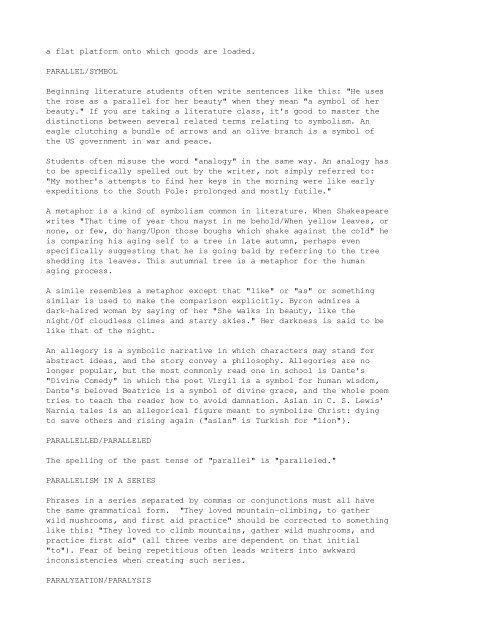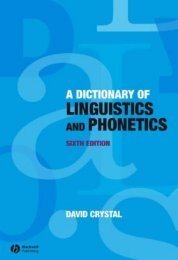Common_Errors_in_English_usage
Common_Errors_in_English_usage
Common_Errors_in_English_usage
Create successful ePaper yourself
Turn your PDF publications into a flip-book with our unique Google optimized e-Paper software.
a flat platform onto which goods are loaded.<br />
PARALLEL/SYMBOL<br />
Beg<strong>in</strong>n<strong>in</strong>g literature students often write sentences like this: "He uses<br />
the rose as a parallel for her beauty" when they mean "a symbol of her<br />
beauty." If you are tak<strong>in</strong>g a literature class, it's good to master the<br />
dist<strong>in</strong>ctions between several related terms relat<strong>in</strong>g to symbolism. An<br />
eagle clutch<strong>in</strong>g a bundle of arrows and an olive branch is a symbol of<br />
the US government <strong>in</strong> war and peace.<br />
Students often misuse the word "analogy" <strong>in</strong> the same way. An analogy has<br />
to be specifically spelled out by the writer, not simply referred to:<br />
"My mother's attempts to f<strong>in</strong>d her keys <strong>in</strong> the morn<strong>in</strong>g were like early<br />
expeditions to the South Pole: prolonged and mostly futile."<br />
A metaphor is a k<strong>in</strong>d of symbolism common <strong>in</strong> literature. When Shakespeare<br />
writes "That time of year thou mayst <strong>in</strong> me behold/When yellow leaves, or<br />
none, or few, do hang/Upon those boughs which shake aga<strong>in</strong>st the cold" he<br />
is compar<strong>in</strong>g his ag<strong>in</strong>g self to a tree <strong>in</strong> late autumn, perhaps even<br />
specifically suggest<strong>in</strong>g that he is go<strong>in</strong>g bald by referr<strong>in</strong>g to the tree<br />
shedd<strong>in</strong>g its leaves. This autumnal tree is a metaphor for the human<br />
ag<strong>in</strong>g process.<br />
A simile resembles a metaphor except that "like" or "as" or someth<strong>in</strong>g<br />
similar is used to make the comparison explicitly. Byron admires a<br />
darkhaired woman by say<strong>in</strong>g of her "She walks <strong>in</strong> beauty, like the<br />
night/Of cloudless climes and starry skies." Her darkness is said to be<br />
like that of the night.<br />
An allegory is a symbolic narrative <strong>in</strong> which characters may stand for<br />
abstract ideas, and the story convey a philosophy. Allegories are no<br />
longer popular, but the most commonly read one <strong>in</strong> school is Dante's<br />
"Div<strong>in</strong>e Comedy" <strong>in</strong> which the poet Virgil is a symbol for human wisdom,<br />
Dante's beloved Beatrice is a symbol of div<strong>in</strong>e grace, and the whole poem<br />
tries to teach the reader how to avoid damnation. Aslan <strong>in</strong> C. S. Lewis'<br />
Narnia tales is an allegorical figure meant to symbolize Christ: dy<strong>in</strong>g<br />
to save others and ris<strong>in</strong>g aga<strong>in</strong> ("aslan" is Turkish for "lion").<br />
PARALLELLED/PARALLELED<br />
The spell<strong>in</strong>g of the past tense of "parallel" is "paralleled."<br />
PARALLELISM IN A SERIES<br />
Phrases <strong>in</strong> a series separated by commas or conjunctions must all have<br />
the same grammatical form. "They loved mounta<strong>in</strong>climb<strong>in</strong>g, to gather<br />
wild mushrooms, and first aid practice" should be corrected to someth<strong>in</strong>g<br />
like this: "They loved to climb mounta<strong>in</strong>s, gather wild mushrooms, and<br />
practice first aid" (all three verbs are dependent on that <strong>in</strong>itial<br />
"to"). Fear of be<strong>in</strong>g repetitious often leads writers <strong>in</strong>to awkward<br />
<strong>in</strong>consistencies when creat<strong>in</strong>g such series.<br />
PARALYZATION/PARALYSIS





